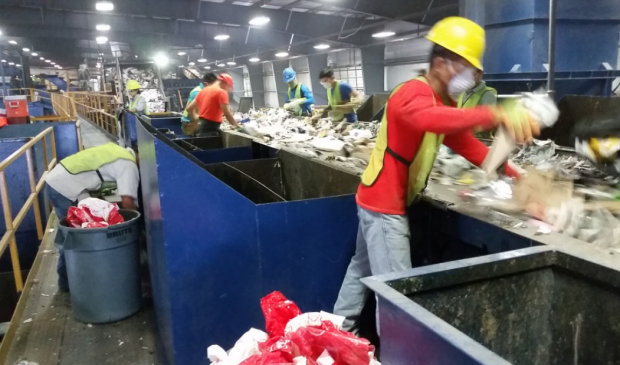Plastic bag ban working to an extent, says report
Friday, June 12, 2015 by
Tyler Whitson Austin’s single-use bag ordinance is helping residents reduce overall consumption by about 197 million single-use bags per year, but it has had unintended consequences including an increase in the number of thicker reusable bags in the recycling stream.
That’s according to a report that Austin Resource Recovery Department Research Associate Aaron Waters presented to the Zero Waste Advisory Commission on Wednesday.
“Across the board, there was a significant reduction in the amount of single-use plastic bags received by the citizens of Austin,” Waters wrote in his report. “From the perspective of judging whether the ordinance was successful in its task, the answer is a resounding ‘yes.’ However, if all other aspects of this issue are considered, the answer becomes less clear.”
Waters calculated that the volume of single-use plastic bags the city eliminates annually would weigh approximately 25 tons, or 50,000 pounds — is equivalent to the weight of about 85 full-sized yellow school buses, 1,707 Texas Longhorn steers, or 6.8 Statues of Liberty.
The report is based on a study the city asked Waters — an intern — to conduct on the ordinance, which went into effect in March 2013. The commission requested the study on Jan. 14 amid concerns that the Texas Legislature would preempt single-use bag ordinances in Austin and other major Texas cities. That did not occur.
The study consisted of a comparative litter analysis between Austin and Fort Worth — based on 2009 baseline data and recent litter clean-up events in both cities — and a comparative recycling stream analysis between Austin and an anonymous Central Texas community.
Neither Fort Worth nor the unnamed community have single-use bag ordinances.
Waters reported that Austin has 75 percent fewer single-use plastic bags in its litter stream than Fort Worth — which has a population that he considered comparable — and 15 times fewer single-use plastic bags in its recycling stream than the unnamed community.
The composition of plastic bags found in the litter stream, however, differs greatly.
Waters said that according to audits of two Austin recycling vendors, reusable plastic bags sold by grocery store chain HEB made up 76 percent of plastic bags in the recycling stream, followed by other reusable bags at 18 percent, branded single-use bags at 3 percent, unbranded single-use bags at 2 percent and HEB single-use bags at 1 percent.
Waters compared this audit to one that Texas Disposal Systems conducted of an unnamed Central Texas community. He found that single-use plastic bags made up 85 percent of total plastic bags in that community, compared to 6 percent in Austin, while reusable plastic bags made up 15 percent of plastic bags in that community, compared to 94 percent in Austin.
Although, according to Waters, Austin had about five times fewer individual plastic bags of all types per pound of recycling, Austin’s higher concentration of heavier reusable bags made the weight comparison less impressive. He reported that plastic bags, by weight, made up .054 percent of Austin’s recycling, compared to .071 percent in the unnamed community.
The ordinance bans retailers such as supermarkets from distributing single-use plastic bags, with some exceptions. It also allows retailers to give away or sell reusable bags that meet certain requirements, most notably that they must be recyclable and at least 4 mils thick, or .004 inches.
Reusable bags — like single-use bags — cannot be recycled through the city’s regular recycling programs and must go to special facilities. Resource Recovery considers them contaminants when they enter the recycling stream because they often get caught in the machinery at materials recovery facilities, which increases costs to the city.
In addition, Waters said, 4 mil reusables are often made from virgin, nonrecycled plastic, require more resources to manufacture and are usually shipped from overseas, increasing their carbon footprint compared to single-use bags.
Resource Recovery Director Bob Gedert said that reusable bags should be able to withstand 100 uses, but he believes that if consumers use them between six and eight times before discarding them, they will have offset the bags’ carbon footprint. “I think the lesson learned from this study is that we need to promote reuse,” he said.
Gedert added that the city would need to study reuse habits in order to understand the full impact that reusable bags have on the environment. “What we don’t know is how many times they’ve been reused,” Gedert continued. “My guess is not enough.”
Commission Chair Rick Cofer said that the city may want to reconsider its definition of a reusable bag in order to make the ordinance more effective.
Waters also wrote in his report that the ordinance increases costs for consumers by increasing the likeliness that they will need to purchase reusable bags and has increased costs for retailers in certain situations.
Specifically, Waters noted a case in which an HEB in north Austin between Wells Branch and Pflugerville said it lost revenue due to customers shopping at nearby retailers that supply single-use bags.
Waters recommended that, in order to improve future results, the city consider eliminating the availability of 4 mil reusable plastic bags, continue to educate consumers on how to properly recycle plastic bags and plastic film, and encourage surrounding communities to adopt single-use bag ordinances.
Photo of Texas Disposal Systems’ materials recovery facility courtesy of Aaron Waters.
This post has been corrected to reflect the fact that 25 tons or 50,000 pounds is not the weight of the volume of plastic sing;e-use bags that the city would eliminate annually.
You're a community leader
And we’re honored you look to us for serious, in-depth news. You know a strong community needs local and dedicated watchdog reporting. We’re here for you and that won’t change. Now will you take the powerful next step and support our nonprofit news organization?







